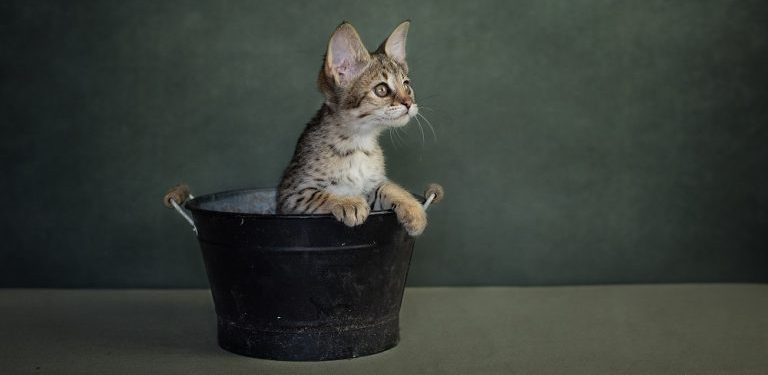About the Savannah Cat Breed
The Savannah cat is a unique and exotic breed that was created by crossing a domesticated cat with the (originally) African Serval. Savannah cats are known for their large stature, slender body, and striking spotted coat that strongly resembles their wild ancestor. Savannahs are not only visually impressive, but also highly intelligent and active. They have a curious and adventurous nature and are good jumpers. Sometimes up to eight feet high!
The Savannah cat breed requires a lot of mental and physical stimulation, and an owner who is willing to invest time in their care and training. Savannahs are social and get along well with other pets and people.
Savannah cat up to F4 banned in the Netherlands from July 1, 2024
As of July 1, 2024, the Pet and Hobby Animals List will come into effect: a list that determines which animals may be kept as a hobby and in a domestic setting. To our great shock and amazement, according to this list, only Savannah cats of F5 and higher may be kept, and cats of F1, F2, F3 and F4 are prohibited. Incomprehensible, because animals that are closer to the serval in appearance also make excellent pets, provided they are kept under the right conditions. The right conditions are understood to mean the living space and living environment. The higher the generation Savannah cat, the more space the cat needs.
Please note: All servals and Savannah cats up to F4, born before July 1, 2024, may be kept.
Our association, the Breed Association Savannah Cat (RVSK) keeps a close eye on all developments and is committed to the continued existence of the Savannah cat as a pet. The fact that the Savannah cat has been banned as of July 1, 2024 is complete nonsense. A Savannah cat is a new breed of cat that does not resemble a serval in character but has more features of a normal domestic cat. Keep an eye on the latest news on the RVSK website for any new developments regarding the Pet and Hobby Animals List.
Savannah Breed Standard
In 1996, Joyce Sroufe wrote the original version of the Savannah Cat Breed Standard and presented it to the board of TICA. 5 Years later the board accepted the species as a registered species. Recognized colors by the breed standard are Brown (Black) Tabby Spotted, Black Silver Spotted Tabby, Black Smoke and Black. No recognized colors are Snow, Blue or the like!
Forbidden Breeds
Unfortunately, there are breeders who use “prohibited breeds” for crossing. These breeds are eg Bengal, Siamese and Maine Coon and are used for other unrecognized colors or sizes. Marble is one such color and comes from the Bengal and is not an addition for a Savannah! Should Marbles be born, the line should be stopped immediately. Crosses of ”forbidden breeds” can also cause unwanted genes with unpleasant consequences, which can lead to unpleasant character traits. Avoid regrets with your purchase, buy a Savannah cat that meets the breed standard. Breeding with unrecognized colors is not quality Savannah!
PLEASE NOTE: An affiliation as a breeder with an association does not have to provide any quality guarantee if the association and its members do not take its own breeding policy seriously. SavannahJungle has therefore founded the R.V.S.K. in collaboration with other breeders, because every member has the intention to take the breeding policy very seriously!
Version 6/1/2013 Savannah (SV) Breed Standard TICA:
We breed according to the TICA BREED STANDARD and therefore purebred with the aim of further developing the Savannah breed. We have set the bar high and our goal is to breed almost perfect Savannah cats.
Our breeding policy with regard to the Savannah cat
The plan is to have a litter of kittens from our Savannah ladies at most once a year, which will be raised in our house. Our kittens leave the house after 14 to 17 weeks and are then vaccinated twice and dewormed several times. The new owner will of course receive a pedigree or pedigree certificate. We do not accept that kittens bred by us are released. There is a good chance that these will be killed or stolen or that cat AIDS or other diseases can arise as a result.
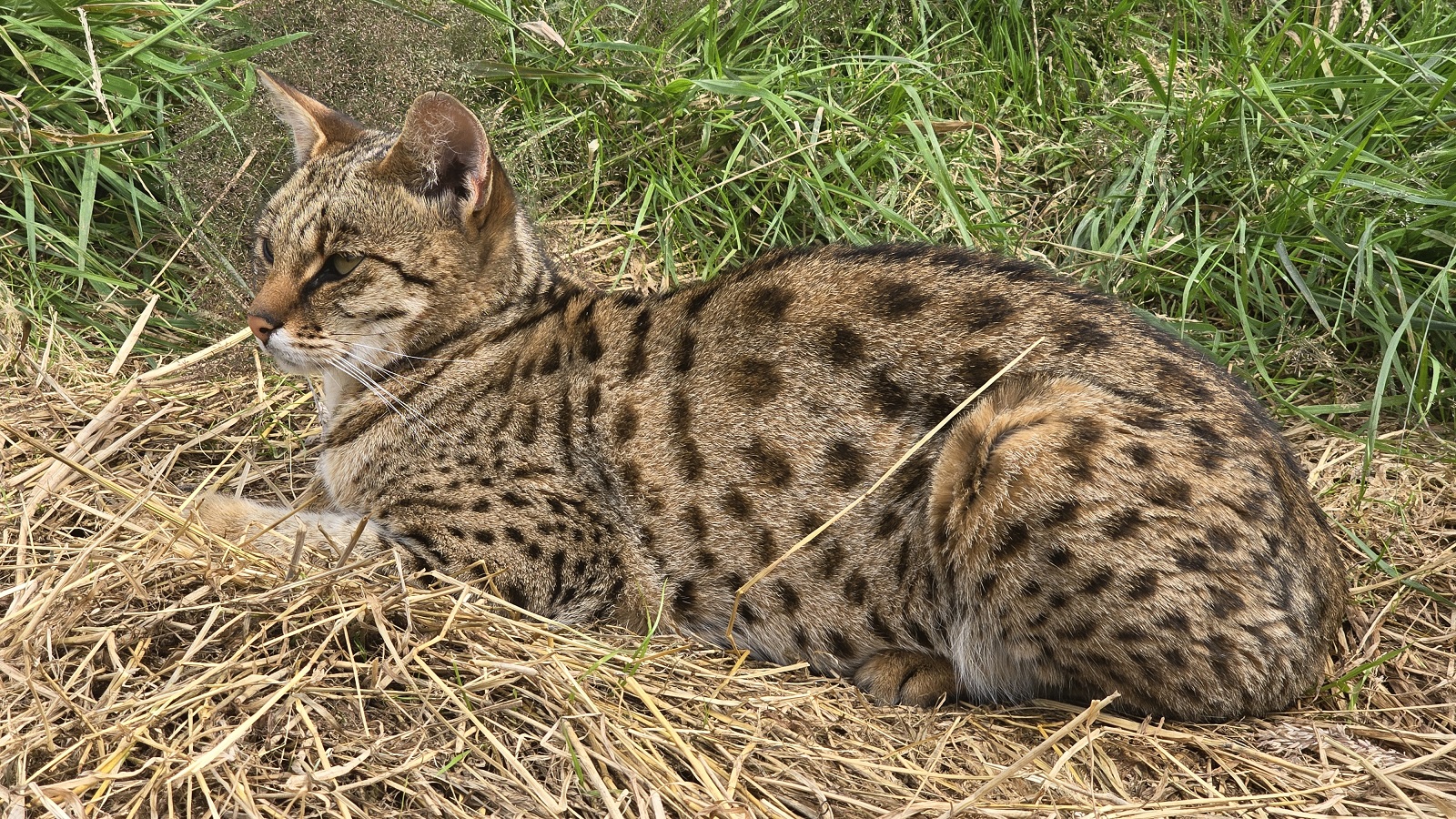
We attach great importance to the health of our animals, which is why they are regularly examined, vaccinated and tested by the vet.
You must provide an indoor and outdoor catio for a Savannah F1, F2 or F3, so that he or she can go outside. Exercise is important for Savannah cats, it is an active cat who also likes it when she can quietly withdraw.
The Origin of the Savannah cat
A Savannah cat is a cross between a domestic cat and the Serval, a medium-sized wild African cat with large ears. An F1 to F4 Savannah male is sterile. A cover is only possible with a male Serval or an F5 male Savannah. With a Serval cat you start again from F1, with a Savannah male cat it depends on the generation of the female or male.
The unusual crossbreed became popular among breeders in the late 1990s. In 2001, TICA recognized the Savannah as a new cat breed. In May 2012 the breed was accepted as Championship Breed, meaning the breed can compete for points in the shows organized by TICA.
Judee Frank, an American breeder of Bengal cats crossed a male Serval cat with a Siamese cat to give birth to the first Savannah cat on April 7, 1986. Frank’s Savannah cat caught the attention of Patrick Kelley, who bought one of the Savannah cat’s kittens in 1989. Kelley was one of the first enthusiasts to work towards a new domesticated breed.
He approached many Serval breeders to help develop this new breed. He eventually got help from breeder Joyce Sroufe, who took the steps with him to get the breed recognized.
How big does a Savannah cat get?
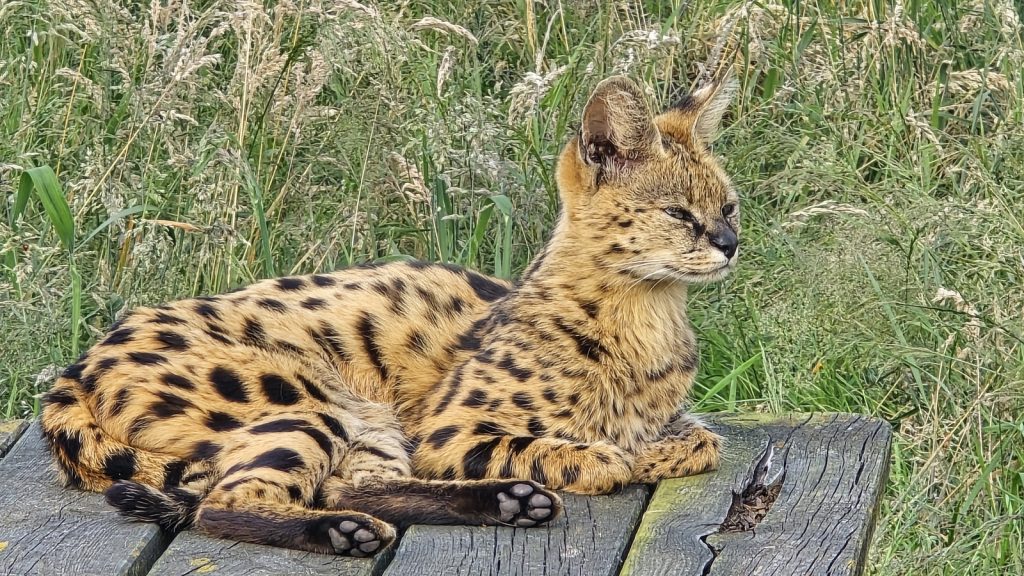
A Savannah has a tall and slender appearance. The size of a Savannah is determined by heredity and how much percentage of serval blood is still present in the Savannah. The higher the percentage of serval blood, the larger he or she is. So by definition an F1 Savannah is bigger than an F2, etc. Also between a Savannah male and a Savannah female there is a significant difference in height. The male F2 or F3 is larger than a regular domestic cat. The females are usually slightly larger than regular house cats.
F1 and F2 usually have a weight between 8 and max. 11 kg. The F3 can still reach the 10 kg. We see examples of this in our breeding. Savannah cats are slow growers and do not reach full height and weight until they are 3 years old.
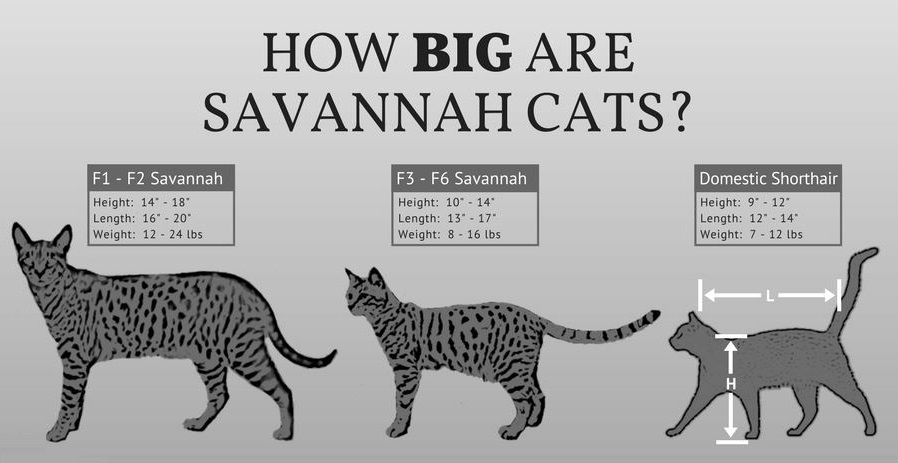
Additional overview:
- F1 male can reach between 40 and 45 cm height at the withers (with approx. 53 -56% serval)
- F1 male with a percentage of 75-77% can reach a height of almost 60 cm.
- F1 female and F2 male between 35 and 40 cm.
- F2 female and F3 male between 30 and 35 cm.
- F3 female, F4 female and male and F5 female and male are the same size as a normal cat.
Of course there are deviations with regard to the above measurements and weights. It is not possible to guarantee in advance how big a female or male cat will grow. Guarantees on this are therefore not possible.
General description (TICA Breed Standard)
The overall impression is a large slender, elegant cat with striking large black spots on gold or orange fur. The Savannah cat is a replica of the Serval cat. He is affectionate and outgoing, with a particularly long neck, legs and ears with a short three-quarter length tail.
The head
The head is broad, moderately wedge-shaped with rounded contours. Seen from the front, the face should form a triangle. It is small in proportion to the body. Seen from the side, the nose is long with a small chin, adding to the cat’s wild appearance. Ears are large and alert with a broad base and slightly rounded tips. Shape of the eyes is between oval and almond shaped. Color should be warm yellow, green, gold or caramel brown. Neck is thick and long muscled.
The body
Body is long and massive. Seen from the side, the sides of the chest and flank form a long triangle. Seen from the front, the Savannah appears narrow due to the extreme length of the body, legs and neck. The Savannah is prominently muscled throughout and yet limber despite being muscular.
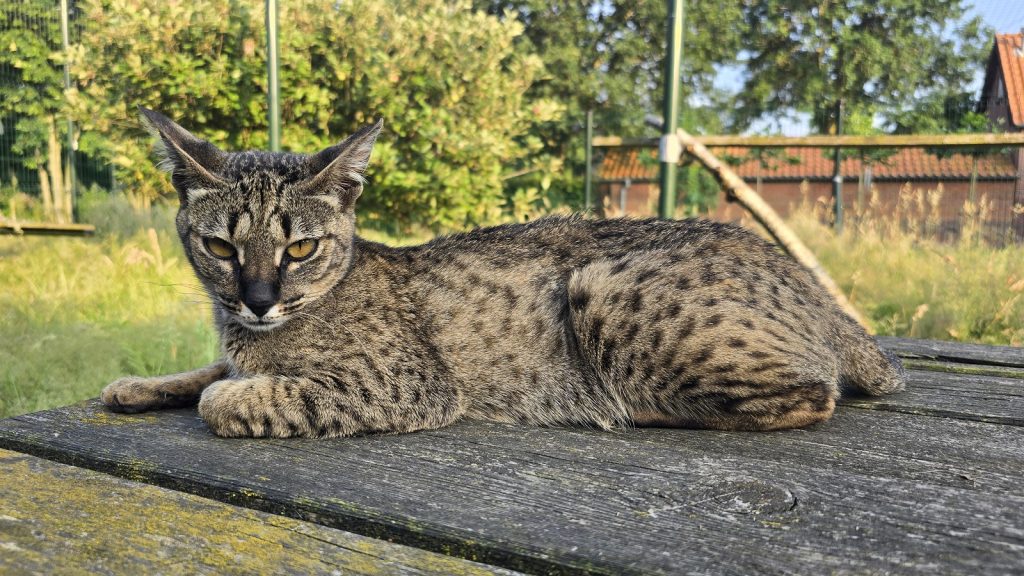
Coat and color
Coat is short to medium length, densely coated, soft and lush. The colors accepted are black, brown spotted tabby, silver spotted tabby and black smoke. The only color variations allowed are golden to orange ground with ‘bold’ black spots, silver ground with ‘bold’ black spots or all black. Preferably with spots.
In each color variation, the lips are black. The prominent tear duct lines on the inside of each eye are also black. In spotted Savannahs the nose can be either brick red or all black or black with a light red or pink line, this line running down the middle. With black Savannahs, the nose should be completely black. The soles of the feet should be coal black or brownish in any color variation. The black Savannah must be all black. Black spots on a black background is the ideal.
Temperament
Savannahs are friendly social cats. They get along well with other pets and their playful temperament makes them quick friends with children. They show their affection by cupping. Most Savannah cats love the outdoors and love to be cuddled. They are elegant jumpers and they love water. They like to take a bath.
Savannah cats love attention and can fetch. The stylish and long-legged appearance, combined with the movement of a wild cat, makes the Savannah incomparable to any other breed.
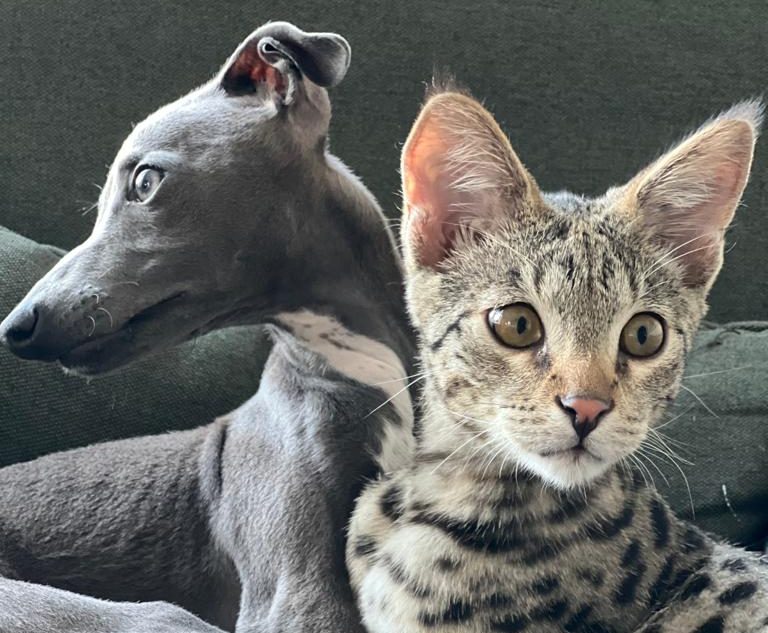
Important tips:
A Savannah needs space, especially F1 and F2 are big. We especially recommend large outdoor areas for F1 and F2; small spaces in a single-family house are really not possible. An F3, F4, F5 etc. are usually the same size as a normal cat and can live in the house.
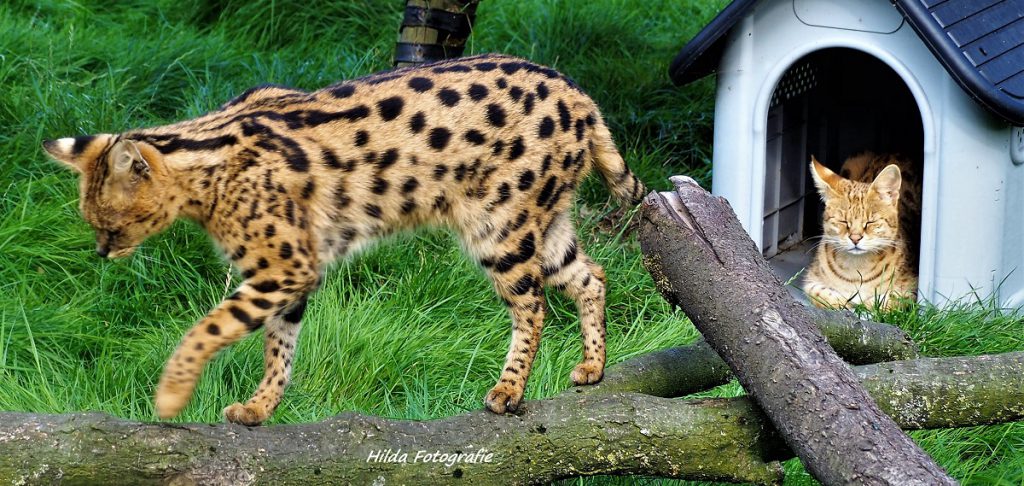
Cats that live in large groups in the living room can get into a fight because of rank and heat. All kinds of diseases can also arise in many cats together, even if you have everything “hygienic” well together. Make sure that there are not too many cats in the living room and living together.
Savannah cats need a lot of exercise. We therefore do not recommend letting a Savannah run free outside. A Savannah cat is still so close to nature that there is a good chance that it can run away and that you will not find it again. That would be a huge waste of such an expensive exotic cat. We therefore recommend a cat wheel, so that the Savannah can lose its energy properly.
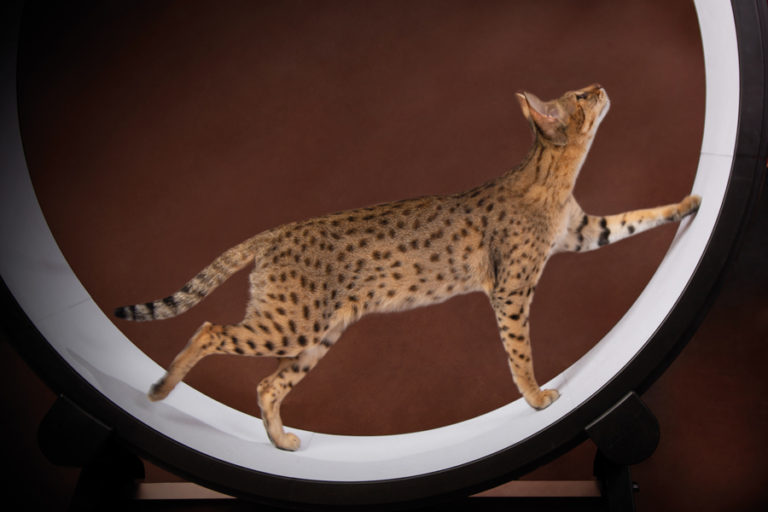
Can a Savannah cat be alone?
We are often asked this question. From our experience and what has also been shown in practice, a Savannah cat can be alone very well. You are really not obliged to take another Savannah or other pet. This choice lies with the owner. We often see that a Savannah is added afterwards, but that is besides the point.
A Savannah cat or kitten from our lines can keep itself busy very well. Almost always, its owner becomes a real “buddy”. It is of course important that there are enough challenges in the house such as toys, climbing posts, cat exercise wheel, etc.
If the owner has to work, go on a visit or go to the supermarket, they can be left alone for a few hours. Savannah cats are just like all other cat species, they can be lazy and sleep a lot, but on the other hand they can also have very active moments.
If the owner is away from home all day because of work and/or a busy private life, it is advisable to take a “buddy” on four legs.
Are you going on holiday?
Our advice is: if possible, leave your cat(s) at home in their own safe environment. Cats generally like this best and it does not cause them any stress. Make good arrangements with family, friends, neighbors or cat sitter so that they come by to take care of the cats. This includes: giving attention, food and clean water and cleaning the litter box(es).
